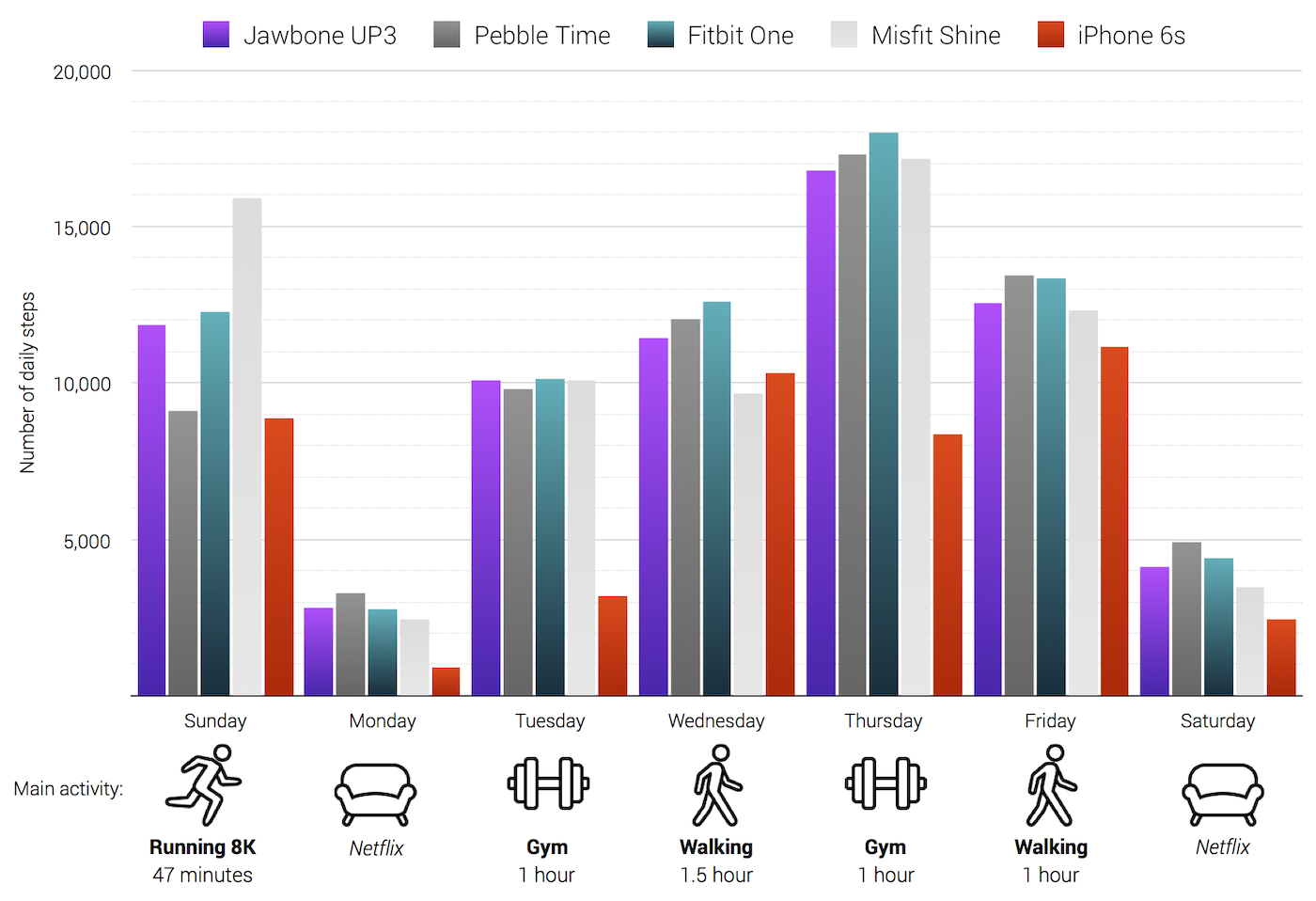A week with 5 different personal trackers: how accurately do they count steps?
This is a questions I often hear when people find out that I wear a small army of personal trackers 24/7. And what’s the point of being a self-appointed guinea pig if you can’t do fun little experiments on your own quantified self, right?
Let’s see what I found out when I compared the step count from 5 different personal trackers from a pretty active week. Each day I wore and tracked my steps with:
- Jawbone UP3 on my left wrist (note: I’m right handed)
- Pebble Time Steel on my left wrist, next to the UP3
- Fitbit One clipped on my pants pocket and on my sports bra during exercise
- Misfit Shine as a necklace (most of the time), on my right wrist (during my run) and in my back pocket (during gym)
I’ve also included data from my iPhone 6s, which uses the Apple M9 motion coprocessor for step counting. Unlike other trackers, I don’t have my iPhone on me during gym, and I usually avoid taking it to the bathroom with me.
To make things fun, I did a few different activities during the week:
- running (Sunday, 8 kilometers in 47 minutes)
- gym training session (Tuesday and Thursday, one hour each day)
- walking trip (Wednesday, 1.5 hours)
- intense walk (Friday, 1 hour)
- rest day (aka Netflix and work day, Monday and Saturday)
I decided to skip cycling because I haven’t found any of the trackers good at figuring out my cycling effort (and I’ve tried wearing them on my ankles).
That’s 5 different trackers, and 4 different activities. And here’s a pretty chart:

There are two big outliers, both on my running day. The most surprising one was the low step count from my Pebble Time. In fact, it came pretty close to the iPhone step count. I am planning to do more running tests with Pebble to see if this was just an accident or whether it really does count less running steps than my other trackers.
Misfit Shine, the other running outlier, does have a better excuse for its unusually high Sunday step count. During this run I wore the Misfit as a bracelet instead of a necklace. Wearing it around my neck is my usual everyday wearing mode, which I’ve also marked in the Misfit app. Misfit also ended up with the lowest step count on walking Wednesday, so it does seem quite sensitive to how it’s worn. Its form factor does give you a lot of wearing options, but this does come at a cost of more unpredictable measurements.
Wrist versus body
I was a bit surprised to see Fitbit taking the lead so often; I expected one of the wrist-worn trackers to take that title. The wrist-worn Pebble Time does come slightly ahead on days when I don’t exercise though. I wonder if this has to do with more steps counted while typing?
The interesting this is that Jawbone UP3 counted less steps than Pebble Time on most days, even though they are worn on the same wrist. This might mean that the UP3 is slightly better at ignoring non-exercising wrist movements (I do want to collect more data before passing the final verdict though).
The iPhone is great at counting steps — when it’s with you
As expected, there’s a noticeable difference in the step count on my gym days, when my iPhone stays in the locker. I do a significant amount of running during gym training, which is obvious from the gap between the iPhone and the other trackers.
And while I wear all other trackers day and night, my iPhone stays on the desk a lot during the day when I’m working. That’s why I was expecting to get the lowest step count from my iPhone every day. But it actually counted more steps than the Misfit Shine on my walking trip on Wednesday.
Overall, the iPhone comes pretty close to wearable trackers on days when I exercise more and have my iPhone with me. If you’re willing to keep your iPhone with you most of the time, you actually have a pretty decent step tracker already built-in!